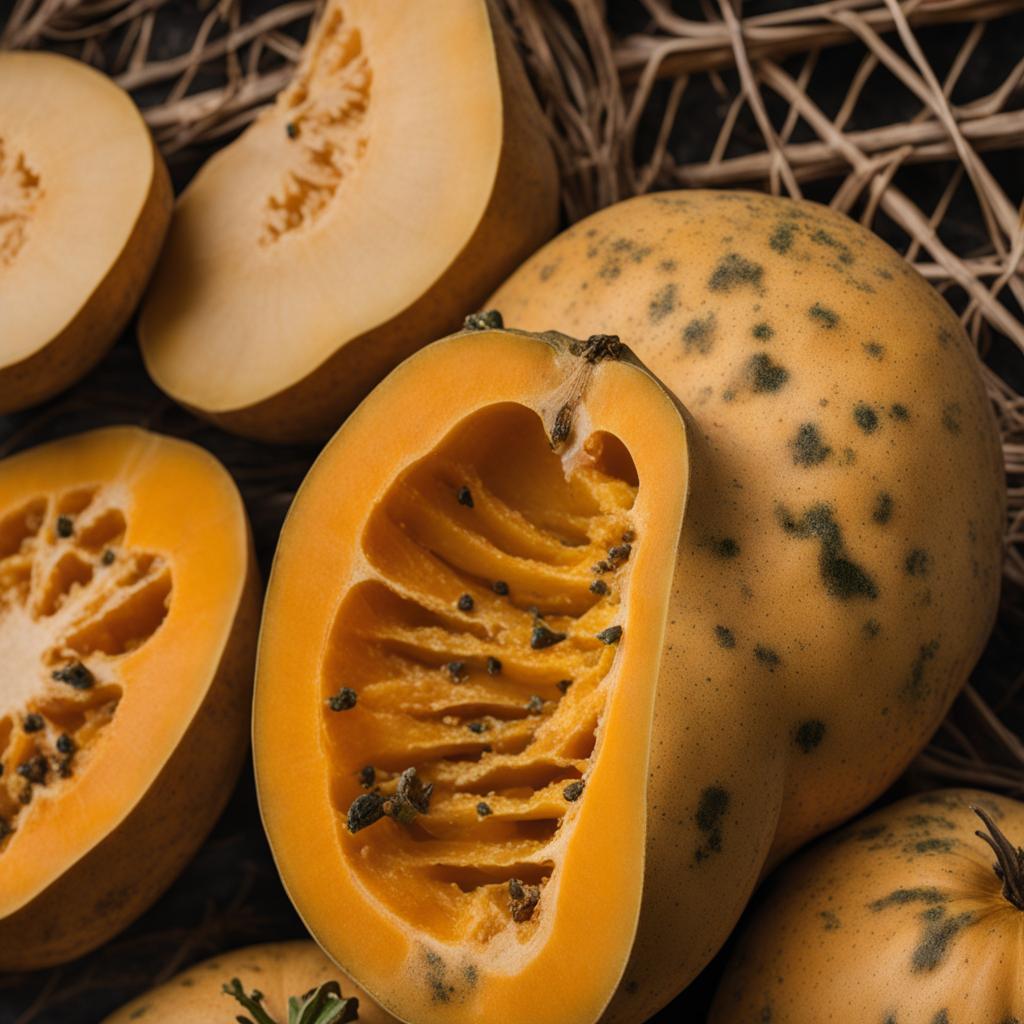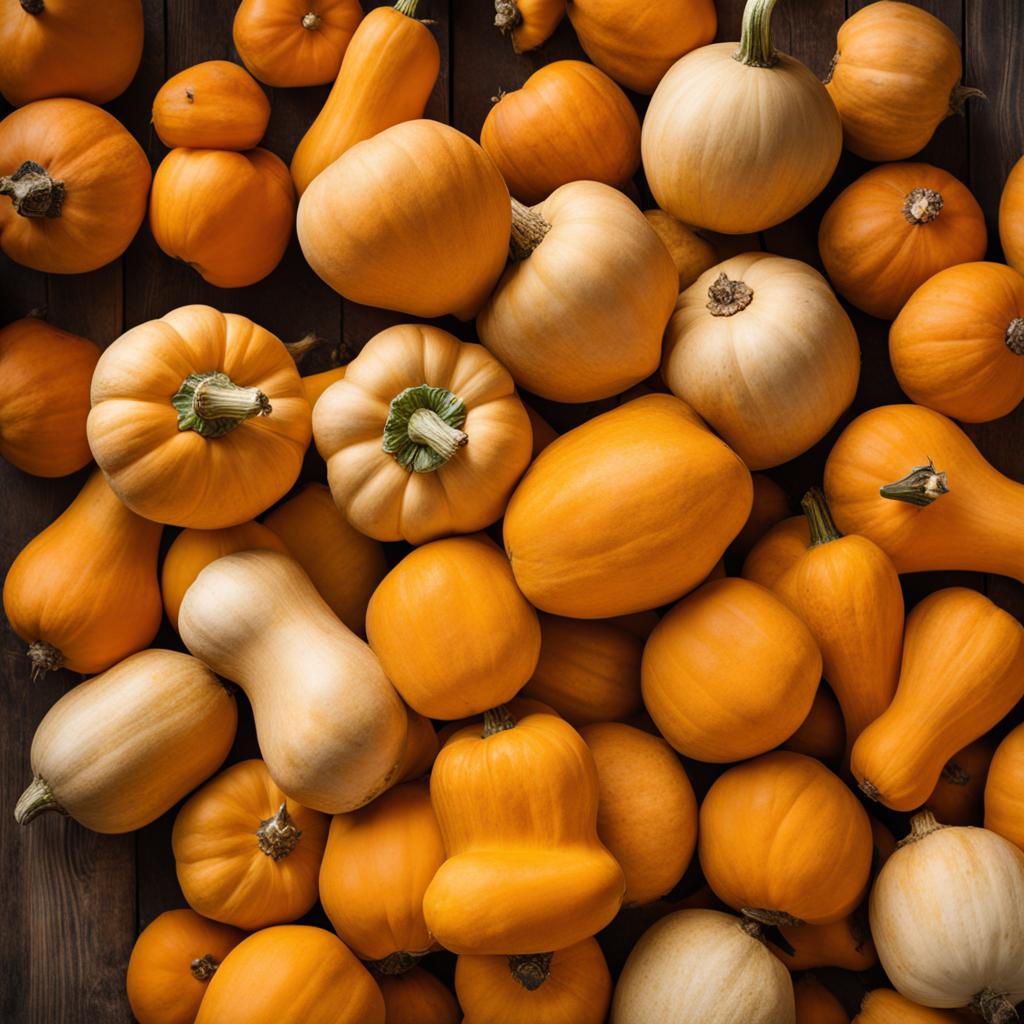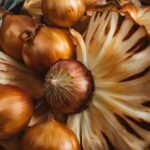Butternut squash is a versatile and popular winter squash that is often used in recipes like soups and casseroles. However, it’s important to know how to tell if butternut squash is bad to avoid consuming spoiled produce. In this article, I will explore the signs of spoilage in butternut squash, including changes in color, texture, odor, and taste. By being able to spot these signs, you can ensure that you are using only fresh and flavorful butternut squash in your culinary creations.
Key Takeaways:
- Knowing how to spot signs of spoilage in butternut squash is essential for ensuring food safety and avoiding unpleasant flavors.
- Pay attention to changes in color, texture, odor, and taste to determine if butternut squash has gone bad.
- Mold, softness, and unusual odors are clear indicators of spoilage in butternut squash.
- Proper storage and understanding the shelf life of butternut squash can help maximize its freshness and flavor.
- By ensuring the quality of the butternut squash you use, you can create delicious and healthy meals in your kitchen.
Can Butternut Squash Go Bad?
Like any other vegetable or fresh whole food, butternut squash can go bad if not stored properly. However, if it is kept in a dry place, butternut squash can last for weeks. It is important to understand the signs of spoilage in order to determine if your butternut squash is still good to use. In the following sections, we will delve into the specific signs of spoilage to look out for when assessing the freshness of your butternut squash.
When it comes to winter squash like butternut squash, it is essential to know that the quality of the squash is influenced by how it was harvested and stored. Freshness is key to enjoying the delicious flavors and textures of butternut squash in your meals. So, let’s explore the signs of spoilage and understand how to identify them.
Now that we’ve established that butternut squash can go bad, let’s dive into the details of how to tell if your butternut squash is still fresh or past its prime. By being able to spot these signs, you can confidently use fresh and flavorful butternut squash in your culinary creations.
How to Determine if a Whole, Uncut Butternut Squash is Bad
When it comes to assessing the freshness of a whole, uncut butternut squash, there are a few key signs to look out for. By paying attention to these indicators, you can ensure that you only use the best quality squash in your recipes. Here are the telltale signs that a whole butternut squash is bad:
- Squishy Spots: If you notice squishy spots on the squash that penetrate through the outer layer, it is a clear indication that it has gone bad.
- Bad Smell: A bad smell emanating from the squash is a strong sign of spoilage. Trust your nose and if the aroma is unpleasant, it’s best to discard the squash.
- Color of Mold: Any color of mold that appears on the skin, rind, stem, or inside the squash is an indication that it is no longer fresh and should not be consumed.
It’s important to note that sometimes the signs of spoilage may not be apparent on the exterior, and it’s only when you cut into the squash that you discover its true condition. Therefore, it’s crucial to thoroughly inspect the whole butternut squash before using it in your culinary creations.
“A bad smell emanating from the squash is a strong sign of spoilage.”
By following these guidelines, you can confidently determine if a whole, uncut butternut squash is bad and avoid using spoiled produce in your cooking.
| Signs of Spoilage | Indications |
|---|---|
| Squishy Spots | Penetration through the outer layer |
| Bad Smell | Unpleasant odor |
| Color of Mold | Any mold on the skin, rind, stem, or inside |
How to Tell If Cut Butternut Squash Is Bad
When it comes to cut, cubed, or sliced raw butternut squash, there are a few key indicators to look out for to determine if it has gone bad. One of the first signs is the texture of the squash. If the liquid that has run off the squash appears slimy and has a foul smell, it is a clear indication that the flesh has degraded and the squash is no longer fresh.
Another visual clue to watch for is the presence of mold. Any mold on the skin or flesh of the butternut squash is a clear sign that it is no longer fit to eat. Mold can appear in various colors, so be sure to thoroughly inspect the squash for any discolorations.
It is also important to note that pre-packaged butternut squash cubes have a limited shelf life. Even if kept refrigerated, they are only good to eat for about three to four days. So, if you come across pre-cut butternut squash that has been in the fridge longer than that, it’s best to discard it to avoid any potential foodborne illnesses.
| Signs of Bad Butternut Squash | Indications of Fresh Butternut Squash |
|---|---|
| Slime and foul smell when liquid runs off squash | Crisp and fresh aroma |
| Presence of mold on skin or flesh | No mold or discoloration |
| Pre-packaged cubes that have been refrigerated for more than three to four days | Pre-packaged cubes within the recommended storage time |
By paying attention to these signs and properly storing your butternut squash, you can ensure that you are using only fresh, high-quality produce in your recipes. It’s always better to be safe than sorry when it comes to food safety, so if you have any doubts about the freshness of your cut butternut squash, it’s best to err on the side of caution and discard it.
Key Takeaways:
- Bad cut butternut squash will have slimy liquid and a foul smell when the liquid runs off.
- Mold on the skin or flesh is a clear indication that the squash is no longer fresh.
- Pre-packaged butternut squash cubes have a limited shelf life and should be consumed within three to four days.
How to tell if stored cut butternut squash is bad
If you have stored cut butternut squash for too long and it has been left uncovered, there are several signs to look out for to determine if it has gone bad. One of the most noticeable signs is that the squash will appear dehydrated, wrinkled, and shrunken. The texture of the squash may also feel softer than it should, indicating spoilage. Additionally, if you notice any mold on the cut surfaces of the squash, it is a clear indication that it is no longer safe to consume. Mold can develop quickly in moist environments, so it’s important to discard the squash if you see any signs of it.
To prevent stored cut butternut squash from going bad, it’s best to keep it covered and in a cool, dry place. Wrapping the cut sides of the squash tightly with plastic wrap can help maintain its freshness. If you have a whole butternut squash that you have cut into, it’s recommended to refrigerate the unused portion to prolong its quality. However, it’s important to note that cut butternut squash will not last as long as whole squash and should be consumed within a few days to ensure its freshness.
How to Tell if Cooked Squash is Bad
After enjoying a delicious meal featuring cooked squash, it’s important to know how to tell if it has gone bad. There are a few key indicators to look out for, such as the texture, smell, and the presence of mold. By being able to identify these signs, you can prevent any potential foodborne illnesses and ensure that you are consuming fresh and safe squash.
One of the first signs that cooked squash has spoiled is a noticeable change in texture. If the flesh of the squash has become excessively moist or slimy, it is a clear indication that it is no longer fresh. Additionally, if you detect a stinky or foul odor coming from the cooked squash, it is best to discard it immediately. A rancid smell is a strong indicator that the squash has gone bad.
Mold is another telltale sign of spoilage in cooked squash. If you notice any presence of mold anywhere on the squash, it is important to throw it away. Mold can indicate the presence of harmful bacteria and consuming moldy food can lead to adverse health effects. It’s better to be safe than sorry when it comes to moldy cooked squash.
“If the texture is excessively moist, the odor is foul, or there is any sign of mold, it’s time to bid farewell to your cooked squash”
Table: Signs of Spoilage in Cooked Squash
| Signs of Spoilage | What it Indicates |
|---|---|
| Excessively moist or slimy texture | The squash has gone bad |
| Stinky or foul odor | The squash is no longer fresh |
| Presence of mold | The squash should be discarded |
In summary, if you notice that your cooked squash has a moist or slimy texture, emits a foul odor, or has any signs of mold, it’s time to bid farewell to your culinary creation. Ensuring that your cooked squash is fresh and safe to eat is essential for maintaining good food safety practices. By being attentive to these signs of spoilage, you can enjoy your meals with confidence and avoid any potential health risks associated with consuming spoiled squash.
Appearance: A key indicator of freshness
When it comes to assessing the freshness of butternut squash, appearance is a key indicator. By observing the skin, color, and texture, you can determine if the squash is still suitable for consumption.
A fresh butternut squash should have a firm skin that is dull and has a uniform beige color. Any mushy spots, bruises, or rotting areas on the skin are indications that the squash is starting to go bad. If you notice any damaged squash with liquid leaking out, it is best to discard it immediately.
It’s also important to inspect the flesh of the squash. If you find any mushy or dark spots, or if the flesh feels stringy or has large areas of discoloration, it’s a clear sign that the butternut squash is no longer fresh and should not be used in your culinary creations.
| Indicators of Freshness | Signs of Spoilage |
|---|---|
| Firm skin | Mushy spots |
| Dull, uniform beige color | Bruises |
| Rotting areas | |
| Damaged squash with liquid leaking out | |
| Firm flesh | Mushy or dark spots |
| Stringy texture | |
| Large areas of discoloration |
By paying attention to the appearance of butternut squash, you can ensure that you are using only fresh and flavorful produce in your kitchen. Remember, when in doubt, it’s always better to err on the side of caution and discard any squash that shows signs of spoilage.
Smell: A telltale sign of spoilage
When it comes to determining the freshness of butternut squash, your sense of smell can provide valuable insights. Paying attention to the scent of the squash can help you identify if it has started to go rancid or if it is still fresh and safe to use in your recipes.
A fresh butternut squash should not have any foul odor. If you detect a foul smell coming from the squash, it is a clear indication that it has changed and is no longer in its optimal state. Trusting your nose and avoiding purchasing or using squash with a rotten smell is essential for ensuring the quality of your dishes.
“A fresh butternut squash should not have any odor. If the vegetable starts to go rancid, the scent will change and become foul.”
So, the next time you’re at the grocery store and come across a butternut squash that looks fine but smells bad, it’s best to avoid buying it. By relying on your sense of smell, you can confidently select the freshest butternut squash for your culinary creations.

Table: Identifying Signs of Spoilage through Smell
| Smell | Indication |
|---|---|
| No odor | Fresh butternut squash |
| Foul odor | Rancid butternut squash |
Checking for Freshness by Feel
When it comes to determining the freshness of butternut squash, our sense of touch can provide valuable insights. By feeling the squash, we can assess its weight, sturdiness, and overall condition. A fresh butternut squash should feel heavy and have a sturdy texture, indicating that it is filled with moisture and nutrients. On the other hand, if the squash feels light and seems empty inside, it may be a sign that the flesh has started to rot or is in the process of spoiling.
In addition to weight and sturdiness, the skin of a fresh butternut squash should be smooth and free from cuts or bruises. Any visible damage to the skin can be an indication that the squash is no longer fresh or is on its way to becoming spoiled. It’s also important to pay attention to the stem of the squash. A firm stem that moves easily is a positive sign of freshness, while a stem that feels mushy or shows signs of mold may indicate that the squash is rotten or getting there.
Overall, using our sense of touch to check for freshness can help us ensure that we are selecting the best butternut squash for our culinary creations. By paying attention to the weight, texture, skin condition, and stem firmness, we can make informed decisions and enjoy the delicious flavors of fresh butternut squash in our favorite recipes.
Table: Signs of Freshness and Spoilage in Butternut Squash
| Signs of Freshness | Signs of Spoilage |
|---|---|
| Heavy weight | Light and empty inside |
| Sturdy texture | Mushy or rotten flesh |
| Smooth skin | Cuts or bruises on the skin |
| Firm stem that moves easily | Mushy or moldy stem |
How Long Does Butternut Squash Last?
When it comes to the shelf life of butternut squash, several factors come into play. How the squash is stored and for how long can determine its freshness and edible quality. Here’s a breakdown of how long different forms of butternut squash can last:
| Form of Butternut Squash | Storage Method | Shelf Life |
|---|---|---|
| Whole Raw Butternut Squash | In a dry place or on the countertop to stop the ripening process | Up to two months |
| Peeled or Cut Raw Butternut Squash | Refrigerated in an airtight container | Around six days |
| Cooked, Pureed, or Cubed Butternut Squash | Refrigerated in a sealed container | About six days |
| Frozen Raw or Cooked Butternut Squash | Frozen in an airtight container or freezer bag | Up to three months |
It’s important to note that these timeframes are approximate guidelines, and the actual shelf life can vary depending on various factors such as the freshness of the squash when purchased and the specific storage conditions. Proper storage is key to maximizing the shelf life of butternut squash and ensuring its optimal taste and quality.
Now that you know how long butternut squash can last, you can plan your meals and grocery shopping accordingly. Whether you decide to use it fresh, refrigerate it, or freeze it, understanding the shelf life of butternut squash allows you to make the most of this delicious and versatile vegetable.
How to Store Fresh Butternut Squash
When it comes to storing fresh butternut squash, it’s important to keep in mind that refrigeration and freezing can cause extreme cold damage or disrupt the ripening process. Therefore, the best way to store fresh butternut squash is at room temperature in a well-ventilated and dry place.
To store your squash properly, place it in an open container like a vegetable rack or wooden crate. This allows for air circulation, which helps maintain the squash’s overall freshness. It’s also important to store it at a temperature ideally between 50 to 59°F, such as in a pantry or cool corner of your kitchen. By following these storage guidelines, you can enjoy the flavor and quality of your fresh butternut squash for up to two months.
Remember, refrigeration and freezing can affect the texture and flavor of fresh butternut squash, so it’s best to store it at room temperature for optimal taste. By keeping your squash in an open container in a well-ventilated and dry place, you can ensure it stays fresh and ready to use in your favorite recipes.

| Storage Method | Location | Temperature Range | Shelf Life |
|---|---|---|---|
| Room Temperature | Well-ventilated, dry place (e.g., vegetable rack, wooden crate) | Ideally between 50 to 59°F | Up to 2 months |
| Refrigeration | Refrigerator | Approximately 32 to 40°F | Up to 6 days (peeled or cut) |
| Freezing | Freezer | 0°F or below | Up to 3 months |
By following the proper storage methods for fresh butternut squash, you can ensure that it stays in prime condition and ready to be used in your culinary creations for weeks or even months. Remember to always check for any signs of spoilage before using the squash, as proper storage can only preserve the freshness of the squash for a certain period of time.
How to Properly Store Butternut Squash in the Fridge
When it comes to storing butternut squash in the fridge, proper handling is essential to maintain its freshness and flavor. Follow these simple instructions to ensure your raw, peeled, or cut butternut squash stays in optimal condition for up to six days.
Instructions:
- Start by using a sharp knife and vegetable peeler to cut and peel your butternut squash as desired.
- Once the squash is peeled, carefully cut it into your preferred size or shape.
- Next, place the cut or peeled squash in an airtight container to prevent it from drying out and absorbing odors from other foods in the fridge.
- Finally, store the container in the refrigerator, where the butternut squash can stay fresh for up to six days.
“Properly storing butternut squash in the fridge is crucial to preserving its freshness and taste. By following these instructions, you can enjoy this nutritious and versatile vegetable for days to come.” – Professional Chef
Remember to discard any butternut squash that shows signs of spoilage, such as mold, foul smell, or slimy texture. To dispose of the peels and stems of your butternut squash, consider using a countertop compost bin for an eco-friendly solution.
| Storage Method | Shelf Life |
|---|---|
| Whole raw butternut squash in a dry place or on the countertop | Up to two months |
| Peeled or cut raw butternut squash in an airtight container in the fridge | Up to six days |
| Cooked, pureed, or cubed squash in the fridge | Up to six days |
| Frozen raw or cooked butternut squash | Up to three months |
By following these storage guidelines, you can extend the shelf life of your butternut squash and enjoy its delicious flavors in a variety of recipes.
Conclusion
In conclusion, determining the freshness of butternut squash is crucial to ensure the quality and safety of your culinary creations. By paying attention to the signs of spoilage, such as changes in appearance, smell, and feel, you can confidently assess the freshness of the squash.
When it comes to appearance, look for a firm skin with a uniform beige color and avoid any mushy spots, bruises, or rotting areas. Trust your sense of smell and avoid squash with a foul odor. Checking the feel of the squash is also important – it should feel heavy, sturdy, and have smooth skin without cuts or bruises.
Proper storage practices are key to maximizing the shelf life of butternut squash. Keep whole squash in a well-ventilated, dry place at room temperature for up to two months. For refrigeration, store peeled or cut squash in an airtight container in the fridge for up to six days. When using butternut squash in recipes, make sure to discard any pieces that show signs of spoilage to prevent foodborne illnesses.
In summary, by understanding the signs of spoilage, practicing proper storage techniques, and using fresh butternut squash, you can maximize the quality and flavor of your dishes. Whether you’re roasting, pureeing, or using it in various recipes, knowing how to determine the freshness of butternut squash is essential for a successful culinary experience.
FAQ
Can butternut squash go bad?
Yes, like any other vegetable or fresh whole food, butternut squash can go bad if not stored properly.
How can I tell if a whole, uncut butternut squash is bad?
You can tell if a whole, uncut butternut squash is bad if you see squishy spots that penetrate through the outer layer of the squash and it has a bad smell. Additionally, any color of mold that appears on the skin, rind, stem, or inside the squash is a clear indication that it has gone bad.
How can I tell if cut, cubed, or sliced raw butternut squash is bad?
You can tell if cut, cubed, or sliced raw butternut squash is bad if the liquid that has run off the squash is slimy and stinky, indicating that the flesh has degraded and smells bad. Furthermore, if you notice mold on the skin or flesh, it is a clear sign that the squash is no longer fresh.
How can I tell if stored cut butternut squash is bad?
You can tell if stored cut butternut squash is bad if it has been left uncovered for too long and appears dehydrated, wrinkled, shrunken, and possibly moldy.
How can I tell if cooked squash is bad?
You can tell if cooked squash is bad if the flesh has become very moist and the liquid is slimy and stinky. Additionally, if you notice the presence of mold anywhere on the cooked squash, it is a clear sign that it has gone bad.
What are the key indicators of freshness in butternut squash?
The appearance of butternut squash is a key indicator of its freshness. A fresh squash should have a firm skin that is dull and has a uniform beige color. Any mushy spots, bruises, or rotting areas on the skin are indications that the squash is starting to go bad.
Does butternut squash have a smell when it goes bad?
Yes, the smell of butternut squash is a telltale sign of spoilage. A fresh butternut squash should not have any odor. If the vegetable starts to go rancid, the scent will change and become foul.
How can I determine the freshness of butternut squash by touch?
A fresh butternut squash should feel heavy, sturdy, and have smooth skin without any cuts or bruises. If the squash feels light and seems empty inside, it is a sign that the “meat” of the squash has turned rotten or is in the process of spoiling.
How long does butternut squash last?
The shelf life of butternut squash can vary depending on how it is stored. A whole raw butternut squash can last for up to two months when stored in a dry place or on the countertop. A peeled or cut raw butternut squash can last for about six days in the refrigerator. Similarly, a cooked, pureed, or cubed squash can last for about six days in the fridge. If you choose to freeze butternut squash, it will likely retain its taste for up to three months.
How should I store fresh butternut squash?
To store fresh butternut squash, place the whole squash in an open container like a vegetable rack or wooden crate to allow for air circulation. Store the squash in a well-ventilated, dry place at a temperature ideally between 50 to 59°F. Consume the squash within two months to ensure optimal taste and freshness.
How should I store butternut squash in the fridge?
To store butternut squash in the fridge, peel and cut the squash using a knife and vegetable peeler. Place the flesh in an airtight container and store it in the fridge. Cut butternut squash can be stored in the refrigerator for up to six days.
Source Links
- https://cookingchew.com/how-to-tell-if-butternut-squash-is-bad.html
- https://ginabnutrition.com/veganism/how-to-tell-if-butternut-squash-is-bad-expert-tips-and-signs-to-look-for/
- https://www.studiodelicious.com/how-to-tell-if-squash-is-bad/
















